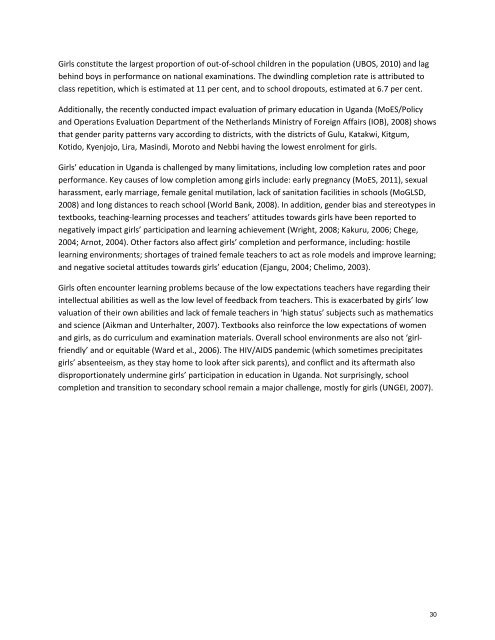Uganda Evaluation - United Nations Girls' Education Initiative
Uganda Evaluation - United Nations Girls' Education Initiative
Uganda Evaluation - United Nations Girls' Education Initiative
You also want an ePaper? Increase the reach of your titles
YUMPU automatically turns print PDFs into web optimized ePapers that Google loves.
Girls constitute the largest proportion of out‐of‐school children in the population (UBOS, 2010) and lag<br />
behind boys in performance on national examinations. The dwindling completion rate is attributed to<br />
class repetition, which is estimated at 11 per cent, and to school dropouts, estimated at 6.7 per cent.<br />
Additionally, the recently conducted impact evaluation of primary education in <strong>Uganda</strong> (MoES/Policy<br />
and Operations <strong>Evaluation</strong> Department of the Netherlands Ministry of Foreign Affairs (IOB), 2008) shows<br />
that gender parity patterns vary according to districts, with the districts of Gulu, Katakwi, Kitgum,<br />
Kotido, Kyenjojo, Lira, Masindi, Moroto and Nebbi having the lowest enrolment for girls.<br />
Girls’ education in <strong>Uganda</strong> is challenged by many limitations, including low completion rates and poor<br />
performance. Key causes of low completion among girls include: early pregnancy (MoES, 2011), sexual<br />
harassment, early marriage, female genital mutilation, lack of sanitation facilities in schools (MoGLSD,<br />
2008) and long distances to reach school (World Bank, 2008). In addition, gender bias and stereotypes in<br />
textbooks, teaching‐learning processes and teachers’ attitudes towards girls have been reported to<br />
negatively impact girls’ participation and learning achievement (Wright, 2008; Kakuru, 2006; Chege,<br />
2004; Arnot, 2004). Other factors also affect girls’ completion and performance, including: hostile<br />
learning environments; shortages of trained female teachers to act as role models and improve learning;<br />
and negative societal attitudes towards girls’ education (Ejangu, 2004; Chelimo, 2003).<br />
Girls often encounter learning problems because of the low expectations teachers have regarding their<br />
intellectual abilities as well as the low level of feedback from teachers. This is exacerbated by girls’ low<br />
valuation of their own abilities and lack of female teachers in ‘high status’ subjects such as mathematics<br />
and science (Aikman and Unterhalter, 2007). Textbooks also reinforce the low expectations of women<br />
and girls, as do curriculum and examination materials. Overall school environments are also not ‘girlfriendly’<br />
and or equitable (Ward et al., 2006). The HIV/AIDS pandemic (which sometimes precipitates<br />
girls’ absenteeism, as they stay home to look after sick parents), and conflict and its aftermath also<br />
disproportionately undermine girls’ participation in education in <strong>Uganda</strong>. Not surprisingly, school<br />
completion and transition to secondary school remain a major challenge, mostly for girls (UNGEI, 2007).<br />
30
















